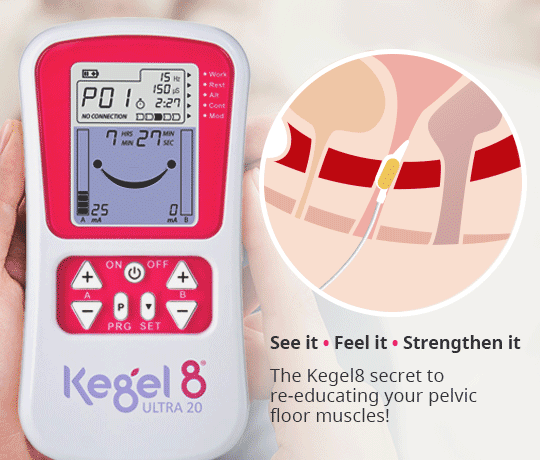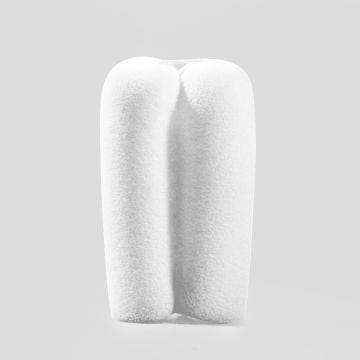
A pessary or vaginal pessary is a removable device, usually body-friendly silicone or rubber that is worn inside the vagina it is designed to add support where the pelvic muscles are weak and pelvic organs have prolapsed or are in danger of prolapse.
- A pessary can be removed at home and cleaned (rinsed under the tap) or if the user finds this difficult at the GP or healthcare professional surgery.
- Some pessaries can be left in place during love making and do not have to be removed for intercourse, however a diaphragm cannot be use with a pessary so an alternative form of contraception is required if the user is pre menopause.
Pessary for Prolapse
Medical research shows that a pessary can actually slow the downward progression of pelvic organ prolapse (POP) and also improve the severity or 'grade' of prolapse. A pessary for prolapse is highly beneficial for a number of reasons:
- A pessary takes the pressure of a weak pelvic floor leaving the woman free to get her muscles strong through pelvic floor exercise, we here at Kegel8 urge as many women as possible to get fitted with a pessary to 'take the strain' whilst they regain pelvic floor muscle strength with a Kegel8 pelvic toner.
- A pessary can help to manage a prolapse, it can help to stop a prolapse getting worse and also prevent further pelvic organ prolapse
- A pessary is perfect for women needing support who want more family and to avoid pelvic surgery
- A pessary is ideal for women who have had prolapse surgery but it has failed. Sadly this is in the region of 1:3 women and following initial prolapse surgery many women are reluctant to go through it again.
- A small study has shown that women with vaginal wind (fanny farts) had less embarrassing episodes when fitted with a pessary.
How does a Pessary Work?
A pessary works to support or 'brace' falling pelvic organs. It can offer a valuable non-surgical approach to prolapse and is clinically proven to improve support and reduce sagging (reducing the genital hiatus). The term genital hiatus is used to describe the distance between the urethra (opening for urine) and the back wall of the vagina. Clinical studies show that genital hiatus size can be reduced when wearing a pessary for some users in as soon as 2 weeks of use! This means that the pessary is reducing the 'sag' of the pelvic floor - now that is great news! After 3 months of pessary use, genital hiatus size decreased significantly. Pessary use results in significant anatomical changes to the genital hiatus in patients with pelvic organ prolapse.
What does a Pessary do?
When the pelvic floor gets weak and loses its support it can result in reduced sensation, leaks of urine, faeces or wind, tampons falling out, lower back pain and hip pain - to name but a few. This weakness can also result in the pelvic organs falling down out of position, so the bladder, uterus, bowel or return can drop down due to lack of support - this is known as prolapse.
Prolapsing or potentially prolapsing pelvic organs need support and if the pelvic floor muscles are also weak a pessary is a great place to start. Current figures show that 1 in 2 women aged 50 will suffer with pelvic organ prolapse and healthcare professionals are keen to pursue alternatives to pelvic floor surgery since the vaginal mesh scandal (2014) and doubts surrounding this major surgery.
Pessary Types:
A pessary is literally a brace or support for the pelvic organs and there are different pessary types, styles and sizes depending on the support required:
Ring Pessary - a hollow ring pessary is ideal to help with stress urinary incontinence. A filled in centre ring pessary is preferred for cystocele (bladder prolapse) and is sometimes referred to as a 'ring pessary with support'. Various symptoms can also be addressed by one pessary, for instance if you have stress incontinence and cystocele you would benefit most from a ring pessary ring with both support and a knob. Stress urinary incontinence can also be treated with a ring pessary with knob
Cube Pessary - A Cube Pessary is recommended for women suffering from moderate to severe uterine prolapse, cystocele or rectocele. The curved edges of the Cube Pessary mean that even if the prolapse is severe, the pessary can stay in place comfortably due to the suction created with the walls of the vagina.
Shelf Pessary - is often recommended for women suffering from a prolapse of the top of vagina or uterine prolapse. They are often used by women with vaginal prolapse who want to avoid surgery such as hysterectomy to help keep the womb prolapse in place.
Gellhorn Pessary - A Gellhorn pessary recommended severe pelvic organ prolapse such as 3rd degree prolapse or procidentia. This is a more solid type of pessary with a stem making insertion and removal at home very easy. A shorter stem Gellhorn pessary is available for women with a short vagina or when the uterus is very low.
Inflatoball Pesssary - The Milex Inflatoball Pessary is a special type of inflatable latex pessary designed for women with the most severe 3rd and 4th degree prolapse, cystocele, rectocele and/or procidentia.
Doughnut Pessary - is slighter larger than ring pessary offering more support, it is a type of pessary often used by women suffering from moderate (2nd or 3rd degree) uterine prolapse and cystocele. The smooth, rounded shape is easily compressed for easy insertion and removal and is also easy to clean.
Falk Pessary - is a solid vaginal pessary designed to support prolapsed organs in women suffering from uterine prolapse. While a pessary cannot cure a womb prolapse, it can help with the everyday symptoms of prolapse and can help to prevent the prolapse from getting worse.
Shaatz Pessary - is designed for use by women who are suffering from a 2nd or 3rd degree uterine prolapse and may also have a cystocele (bladder prolapse). The rounded, slightly domed shape is flexible for easy insertion and provides support to the prolapsed organ which can help to relieve the symptoms of prolapse. The use of a Shaatz pessary, along with pelvic floor exercise to treat the underlying cause of prolapse, is recommended as a first-line treatment for pelvic organ prolapse.
Gehrung Pessary - is designed to help women suffering from moderate to severe cystocele (2nd and 3rd degree bladder prolapse), rectocele and 2nd and 3rd degree uterine prolapse. The Gehrung Pessary is one of the most difficult pessaries to insert, however can provide great results for women suffering from pelvic organ prolapse. Pessaries and pelvic floor exercise are recommended as a first-line treatment for women suffering prolapse as they can help to treat the symptoms of prolapse and help women to avoid prolapse surgery.
Dish Pessary - is a commonly used type of vaginal pessary designed to provide support for women suffering from stress incontinence, mild (1st or 2nd degree) uterine prolapse and mild (1st or 2nd degree) cystocele. The Dish Pessary is simply inserted into the vagina and provides support for the prolapsed organs. While a pessary cannot cure a prolapse, it can help you to manage the symptoms by giving support to the 'dropped' organs. Pessaries, in conjunction with pelvic floor exercise, are recommended as first-line treatment for Pelvic Organ Prolapse (POP). Clinical studies show that the use of a pessary can be of significant benefit to a prolapase1.
Hodge Pessary - is designed to provide support to the prolapsed bladder in women suffering from cystocele (bladder prolapse). A Hodge pessary is available with or without a 'knob' - if you suffer from stress incontinence, this knob can be used to apply gentle pressure to the urethra to prevent leaks.
By using a pessary a woman has a really useful supporting tool for her Pelvic Organ Prolapse (POP) and/or Stress Urinary Incontinence (SUI) because a pessary can help to support the 'dropped' organs and give relief from the 'dragging' symptoms of prolapse.
The use of a pessary along with pelvic floor exercise is recommended as a first-line treatment for pelvic organ prolapse and whilst a pessary cannot cure prolapse, clinical results show that it has a positive effect and can stop from getting worse.
How to use a Pessary
There are different styles, shapes and sizes of pessary and your clinician will fit one depending on your requirements. It is vital that your pessary is fitted by a professional - this is to ensure the right fit. Sadly many women have 'tried' a pessary but say it doesn't work, or 'fell out'. If a pessary falls out it was not the right size and we urge you to return to your healthcare provider and have another go. For a successful pessary fitting your clinician will use the largest pessary possible, a well fitted pessary will feel comfortable, it won't fall out, and it won't interfere with the emptying of your bladder or bowel.
A pessary for prolapse is ideal for women wanting to keep active and avoid surgery. Since one of the most popular prolapse surgeries fell out of favour due to the controversy surrounding vaginal mesh the humble pessary has been thrust into the spotlight - and quite rightly so! To date transvaginal mesh has become the most sued-over medical device in US history and will probably follow suit here in the UK. There has never been a 'quick fix' for prolapse but we now understand that with careful management a prolapse can be managed with:
- Targeted pelvic floor strengthening exercise - that’s where Kegel8 Ultra 20 can help with special programmes for deep effective exercise that is clinically proven (and it's made here in the UK).
- Lifestyle changes, weight reduction, stop smoking, low impact sports, no straining!
- Vaginal pessary to add support and stabilise the prolapse.
Sources:
[1] Obstet Gynecol. 2008 Sep;112(3):630-6. doi: 10.1097/AOG.0b013e318181879f Jones K1, Yang L, Lowder JL, Meyn L, Ellison R, Zyczynski HM, Moalli P, Lee T.






